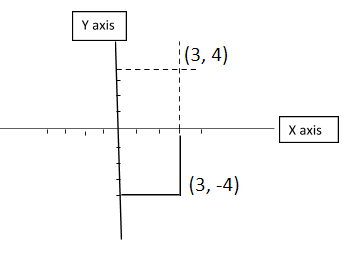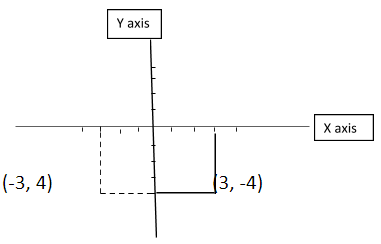
Write the reflection of point B (3, -4) in x-axis and y-axis.
Answer
554.4k+ views
Hint:
To find the reflection of a point along the x-axis, keep the abscissa constant and see the reflection of ordinate along the x-axis. Similarly, for the ordinate of the point.
Formula Used:
The reflection of point (x, y) along x axis is (x, -y)
And the reflection of this point along y axis is (-x, y)
Complete step by step solution:
We have to find the reflection of a given point along the x-axis as well as y-axis.
The given point is B (3, -4)
Now, to find the reflection of this point along the x-axis keep the abscissa constant and see the reflection of this point along the x-axis.
That is,

So, the reflection of point B (3, -4) along the x-axis is (3, 4).
Now we will see reflection point B (3, -4) along y-axis,
For this keep the ordinate constant and see the reflection of abscissa along y axis.
That is,

So, the reflection of point B (3, -4) along the y-axis is (-3, 4).
Additional Information:
Reflections in the coordinate plane:
Reflect over the x-axis: When you reflect a point across the x-axis, the x-coordinate remains the same, but the y-coordinate is transformed into its opposite (its sign is changed).
The reflection of the point (x, y) across the x-axis is the point (x, -y).
Reflect over the y axis: When you reflect a point across the y-axis, the y-coordinate remains the same, but the x-coordinate is transformed into its opposite (its sign is changed).
The reflection of the point (x, y) across the y-axis is the point (-x, y).
Reflect over the y=x: When you reflect a point across the line y=x, the coordinate and y-coordinate change places. If you reflect over the line y=-x, the coordinate and y-coordinate change places and are negated (the signs are changed).
The reflection of the point (x, y) across the line y=x is the point (y, x).
The reflection of the point (x, y) across the line y= -x is the point (-y, -x).
Note:
Reflection over the x-axis: When you reflect a point across the x-axis, the x-coordinate remains the same, but the y-coordinate is transformed into its opposite (its sign is changed).
The reflection of the point (x, y) across the x-axis is the point (x, -y).
Reflection over the y axis: When you reflect a point across the y-axis, the y-coordinate remains the same, but the x-coordinate is transformed into its opposite (its sign is changed).
The reflection of the point (x, y) across the y-axis is the point (-x, y).
To find the reflection of a point along the x-axis, keep the abscissa constant and see the reflection of ordinate along the x-axis. Similarly, for the ordinate of the point.
Formula Used:
The reflection of point (x, y) along x axis is (x, -y)
And the reflection of this point along y axis is (-x, y)
Complete step by step solution:
We have to find the reflection of a given point along the x-axis as well as y-axis.
The given point is B (3, -4)
Now, to find the reflection of this point along the x-axis keep the abscissa constant and see the reflection of this point along the x-axis.
That is,

So, the reflection of point B (3, -4) along the x-axis is (3, 4).
Now we will see reflection point B (3, -4) along y-axis,
For this keep the ordinate constant and see the reflection of abscissa along y axis.
That is,

So, the reflection of point B (3, -4) along the y-axis is (-3, 4).
Additional Information:
Reflections in the coordinate plane:
Reflect over the x-axis: When you reflect a point across the x-axis, the x-coordinate remains the same, but the y-coordinate is transformed into its opposite (its sign is changed).
The reflection of the point (x, y) across the x-axis is the point (x, -y).
Reflect over the y axis: When you reflect a point across the y-axis, the y-coordinate remains the same, but the x-coordinate is transformed into its opposite (its sign is changed).
The reflection of the point (x, y) across the y-axis is the point (-x, y).
Reflect over the y=x: When you reflect a point across the line y=x, the coordinate and y-coordinate change places. If you reflect over the line y=-x, the coordinate and y-coordinate change places and are negated (the signs are changed).
The reflection of the point (x, y) across the line y=x is the point (y, x).
The reflection of the point (x, y) across the line y= -x is the point (-y, -x).
Note:
Reflection over the x-axis: When you reflect a point across the x-axis, the x-coordinate remains the same, but the y-coordinate is transformed into its opposite (its sign is changed).
The reflection of the point (x, y) across the x-axis is the point (x, -y).
Reflection over the y axis: When you reflect a point across the y-axis, the y-coordinate remains the same, but the x-coordinate is transformed into its opposite (its sign is changed).
The reflection of the point (x, y) across the y-axis is the point (-x, y).
Recently Updated Pages
Master Class 8 Maths: Engaging Questions & Answers for Success

Class 8 Question and Answer - Your Ultimate Solutions Guide

Master Class 7 Maths: Engaging Questions & Answers for Success

Class 7 Question and Answer - Your Ultimate Solutions Guide

Master Class 6 Maths: Engaging Questions & Answers for Success

Class 6 Question and Answer - Your Ultimate Solutions Guide

Trending doubts
What is meant by exothermic and endothermic reactions class 11 chemistry CBSE

Which animal has three hearts class 11 biology CBSE

10 examples of friction in our daily life

One Metric ton is equal to kg A 10000 B 1000 C 100 class 11 physics CBSE

1 Quintal is equal to a 110 kg b 10 kg c 100kg d 1000 class 11 physics CBSE

Difference Between Prokaryotic Cells and Eukaryotic Cells




